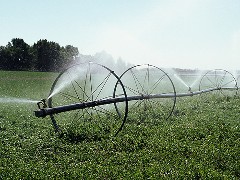Features
Concern over water rates
Date: 2009-04-17 12:12:12.0
Author: Jon Evans

In all the debate over energy balance, indirect land use change and effect on food prices, one potentially problematic aspect of biofuels has tended to be overlooked: water consumption. A major reason for this is the lack of accurate figures for the amount of water used in biofuel production, but most experts agree that it’s probably a lot. And that water consumption could be the Achilles heel in the widespread adoption of biofuels.
Water scarcity is already a major problem in many areas of the world and could soon start to become more common in the developed world. This is because water consumption is currently doubling roughly every 20 years, due to both population growth and industrial expansion. According to Population Action International, a US advocacy group, this could result in the number of people living in water-scarce or water-stressed conditions increasing from 745 million in 2005 to over 3 billion by 2025. And the concern is that the widespread adoption of biofuels could help exacerbate this water scarcity.
Just such a concern was raised recently by the United Nations (UN) in its latest World Water Development Report, which stated that it takes, on average, a staggering 2,500L of water to produce 1L of liquid biofuel. The vast majority of this water is needed to grow the plant feedstock, with only a relatively minor amount used by biorefineries to transform the plant feedstock into biofuel.
It’s true that much of this water comes in the form of rain, which is essentially a free resource that has no impact on water scarcity. But this still leaves around 820L of water that need to be supplied by irrigation. As a result, global biofuel production currently uses around 2% of all irrigation water, but with rising production this figure could increase to 5% by 2030.
Although this doesn’t sound like a huge increase, the report argues that it could have major impacts in areas of the world that rely on irrigation but don’t have huge water supplies. This includes countries such as India and China and even some parts of the US.
The variable nature of the impacts was also highlighted in a paper recently published in Environmental Science and Technology. This paper outlined the findings of one of the first studies to conduct a detailed assessment of the amount of water needed to produce a liter of biofuel in different parts of the US, from field to fuel pump.
Conducted by a team of scientists from the University of Minnesota, the study specifically looked at the amount of man-supplied water needed to produce 1L of corn-derived bioethanol in 41 corn-producing states. As such, they ignored any contribution from rain water.
They discovered that the amount of man-supplied water differed vastly between different states – producing 1L of bioethanol required just 5L of water in Ohio but over 2000L in California. The difference was almost entirely due to the amount of irrigation water that needed to be applied: in Ohio, rain supplied the vast majority of the water needed to grow the corn, but in California much more irrigation water was required.
Interestingly, the states requiring the most irrigation water to produce 1L of bioethanol tended to be those that are predicted to be most at risk of suffering some form of water scarcity in the future. Based on their findings, the scientists argue that any further biofuel expansion should be concentrated in those states that require the least amount of irrigation water to grow corn. Indeed, they calculated that expanding biofuel production to produce 57 billion liters of corn-derived bioethanol by 2015, as required under the US Renewable Fuels Standard, would require 61 billion liters of water if that expansion took place in the three most water-efficient states. But if it took place in the seven least water-efficient states, then it would require 2.4 trillion liters of water.
And what is true of the US is also true of the wider world. According to the UN World Water Development Report, it takes 3,500L of irrigation water to produce 1L of bioethanol from sugarcane in India. Whereas in Brazil and Europe, the share of irrigation water in biofuel production is negligible.
The views represented here are solely those of the author and do not necessarily represent those of John Wiley and Sons, Ltd. or of the SCI.
Displaying 9 keywords used to tag this article:
- fossil fuels
- GHG
- range fuels
- corn
- climate change
- soybean
- Great
- rice
- environment
